The secretive US factory that lays bare the contradiction in Trump’s America First plan


Faisal Islam
Reporting fromArizona

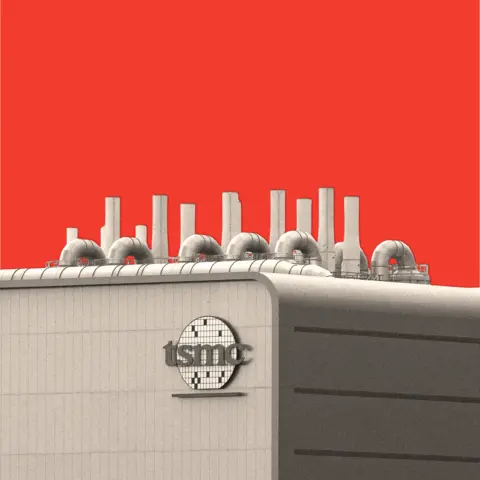 BBC
BBC
Among the cactuses in the desert of Arizona, just outside Phoenix, an extraordinary collection of buildings are emerging that will shape the future of the global economy and the world.
The hum of further construction is creating not just a factory for the world’s most advanced semiconductors. Eventually, it will mass produce the most advanced chips in the world. This work is being done in the US for the first time, with the Taiwanese company behind it pledging to spend billions more here in a move aimed at heading off the threat of tariffs on imported chips.
It is, in my view, the most important factory in the world, and it’s being built by a company you’ve never heard of: TSMC, the Taiwan Semiconductor Manufacturing Company. It makes 90% of the world’s advanced semiconductors. Until now they were all made in Taiwan, the island off the Chinese mainland. The Apple chip in your iPhone, the Nvidia chips powering your ChatGPT queries, the chips in your laptop or computer network, all are made by TSMC.
Its Arizona facility “Fab 21” is closely guarded. Blank paper or personal devices are not allowed in case designs are leaked. It houses some of the most important intellectual property in the world, and the process to make these chips is one of the most complicated and intensive in global manufacturing.


They’re hugely protective of the secrets that lie within. Important customers, such as Apple and Nvidia, trust this company to safeguard their designs for future products.
But after months of asking, TSMC let the BBC in to look at the partial transfer of what some argue is the most critical, expensive, complex and important manufacturing in the world.
The poster child for Trump’s policy
President Trump certainly seems to think so. He often mentions the factory in passing. “TSMC is the biggest there is,” he has said. “We gradually lost the chip business, and now it’s almost exclusively in Taiwan. They stole it from us.” This is one of the US President’s regular refrains.
TSMC’s recent decision to expand its investments in the US by a further $100bn (£75bn) is something Trump attributes to his threats of tariffs on Taiwan and on the global semiconductor business.
The expansion of the Arizona facility, which was announced in March is, he believes, the poster child for his economic policies – in particular the encouragement of foreign companies to relocate factories to the US to avoid hefty tariffs.

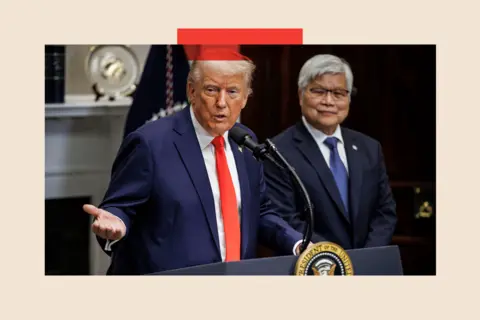 Getty
Getty
China is also watching developments carefully. Taiwan’s chip making prowess has been part of what its government has called its “Silicon Shield,” against a much-feared invasion. While the original strategy was to make Taiwan indispensable in this area of critical technology, the pandemic supply chain difficulties changed the calculus because relying on a single country seemed like a greater risk.
So, many currents of the world economy, frontier technology and geopolitics flow through this one site and within it lies the essential contradiction of Trump’s economic and diplomatic policy.
He sees this plant as the exemplar of America First, and the preservation of economic and military superiority over China. Yet the manufacture of these modern miniaturised miracles at the frontier of physics and chemistry inherently rely on a combination of the very best technologies from around the world.
The cleanest environment on Earth
Greg Jackson, one of the facilities managers, takes me around in a golf buggy. The factories are almost a carbon copy of the TSMC spaces in Taiwan, where he trained. “I would say these facilities are probably some of the most advanced and complicated in the world,” he says.
“It’s quite the dichotomy. You’ve got really, really small chips with really small structures, and it takes this massive facility with all the infrastructure to be able to make them… Just the sheer complexity, the amount of systems that it takes, is staggering.”
Inside the “Gowning Building,” workers dress in protective clothing before crossing a bridge that is supposed to create the cleanest environment on Earth, in order to protect the production of these extraordinary microscopic transistors that create the microchips underpinning everything.
Konstantinos Ninios, an engineer, shows me some of the very first productions from TSMC Arizona: a silicon wafer with what is known as ‘4 nanometre chips’.

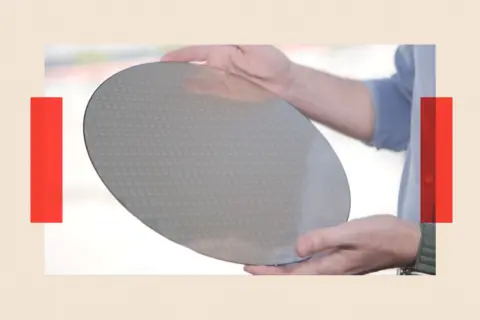
“This is the most advanced wafer in the US right now,” he explains. “[It] contains about 10 to 14 trillion transistors… The whole process is three to 4,000 steps.”
If you could somehow shrink your body to the same scale and get inside the wafer, he says that the many different layers would look like very tall streets and skyscrapers.
Manufacturing manipulation of atoms
TSMC was founded at the behest of the Taiwanese government in 1987, when chip executive Morris Chang was directed to start the business. The model was to become a dedicated foundry for microchips – manufacturing other companies’ designs. It became wildly successful.
Driving the advancement of the technology is the miniaturisation of the smallest feature on chips. Their size is measured these days in billionths of a metre or nanometres. This progress has enabled mobile phones to become smartphones, and is now setting the pace for the mass deployment of artificial intelligence.
It requires incredible complexity and expense through the use of “extreme ultraviolet (UV) light”. This is used to etch the intricate building blocks of our modern existence in a process called “lithography”.
The world’s dependence on TSMC is built on highly specialised bus-sized machines, which are in turn sourced almost entirely from a Dutch company called ASML, including in Arizona.
These machines shoot UV light tens of thousands of times through drops of molten tin, which creates a plasma, and is then refracted through a series of specialised mirrors.
The almost entirely automated process for each wafer of silicon is repeated thousands of times in layers over months, before the $1m LP-sized wafer of 4nm silicon chips is formed.
“Just imagine a particle or a dust particle falling into this,” Ninios says to me incredulously. “The transistors are not going to work. So all of this is cleaner than hospital operating rooms.”
Caution in Taiwan
Taiwan does not have special access to the raw materials – but it has the know-how to stay years ahead of other companies in the intricate process of producing these atomic building blocks of modern life.
Some in the Taiwanese government are cautious about spreading the frontier of this technology off the island. Trump wasted little time in claiming the firm’s decision to bring its highest level of technology to the US was due to his economic policies.
He said this would not have happened without the stick of his planned tariffs on Taiwan and semiconductors. Those I speak to at TSMC are diplomatic about that claim.
Much of this was already planned and subsidised under former US President Biden administration’s Chips Act.

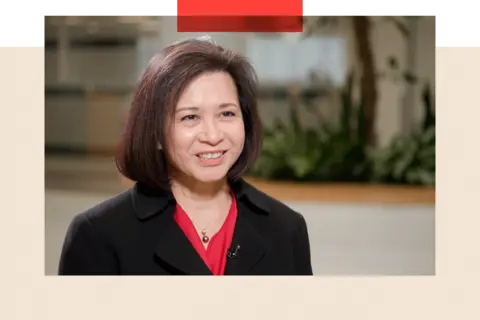
On the walkway into the building are photographs showing Biden’s visit in 2022, with the building site draped in the Stars and Stripes and a banner saying “a future Made in America”.
“The semiconductor supply chain is global,” says Rose Castanares, the President of TSMC Arizona. “There’s really no single country at this moment that can do everything from chemicals to wafer manufacturing to packaging, and so it’s very difficult to unwind that whole thing very quickly.”
‘Non Red’ supply chains to counter China
As for the semiconductor supply chain, tariffs will not help. The supply chain stretches all over the world. Whether it’s the silicon wafers from Japan, the machines required from the Netherlands, or mirrors from Germany, all sorts of materials from all around the world are required. Now, they could face import charges.
That said, TSMC’s boss was quick off the mark in confirming the expansion of the US site at an event with Trump at the White House. In recent weeks, America’s tech elite – from Apple’s Tim Cook, to Nvidia’s Jensen Huang – have been queueing up to tell the world that TSMC Arizona will now produce many of the chips in their US products.
The global chip industry is very sensitive to the economic cycle, but its cutting edge technology enjoys very healthy margins, that could cushion some of these planned tariffs.

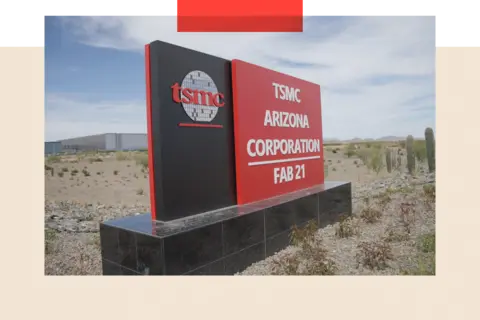
There are many geopolitical subtexts here. The factory sits at the heart of US strategy to gain technological, AI and economic supremacy over China.
Both the Biden and Trump administrations have developed policies to try and limit Chinese access to the frontier semiconductor technology – from a ban of exports to China of ASML’s machines, to new legislation to ban the use of Huawei AI chips in US software or technology anywhere in the world.
Taiwan’s President Lai this week urged democracies such as Japan and the US to develop “non-Red” supply chains to counter China.
Not everyone is convinced that this strategy is working, however. Chinese technologists have been effective at working around the bans to develop competitive indigenous technology. And Bill Gates this week said that these policies “have forced the Chinese in terms of chip manufacturing and everything to go full speed ahead”.
Trump wants TSMC Arizona to become a foundation stone for his American golden age. But the company’s story to date is perhaps the ultimate expression of the success of modern globalisation.
So for now, it’s a battle for global tech and economic supremacy, in which Taiwan’s factory technology, much of which is now being moved to the Arizona desert, is the critical asset.
Top picture credit: Getty
BBC InDepth is the home on the website and app for the best analysis, with fresh perspectives that challenge assumptions and deep reporting on the biggest issues of the day. And we showcase thought-provoking content from across BBC Sounds and iPlayer too. You can send us your feedback on the InDepth section by clicking on the button below.







